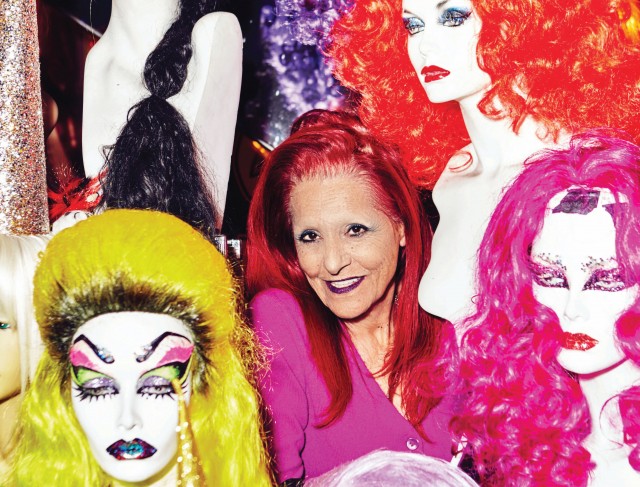We caught up with celebrated stylist Patricia Field as she prepared to close her legendary New York store. But for this iconic septuagenarian, the end of an era is more like a new beginning.
Photo by Danielle St. Laurent
You may not know Patricia Field’s name, but it’s impossible not to have seen her work. As the costume designer for Sex and the City, the most fashion-forward show of the late ’90s and early aughts, she was responsible for Carrie’s tutu in the title sequence and that classic nameplate necklace. The Emmy Award-winning stylist also worked on Ugly Betty, Younger, both Sex and the City movies, and The Devil Wears Prada, just to name a few. But forging fashion for television and film isn’t her only claim to fame. She’s also been letting her freak flag fly at her namesake N.Y.C. store since 1966, where her curated selection of boundary-pushing clothes, accessories, and wigs from cutting-edge designers has been a Lower East Side staple for the city’s club kids and drag queens.
Now 75, Field is closing her influential retail outpost where Keith Haring’s work is still on display and Jean-Michel Basquiat once sold hand-painted clothes. When I arrive there, the man behind the counter has a giant splatter of glitter dripping down his head, a look that pretty much sums up the store’s clientele. Field takes me to her basement office, where we’re flanked by her two small white fluffy dogs, Puti and Sultana, and racks of frocks hand painted by her current art world faves like Scooter LaForge. Her voice is gravelly from years of smoking (she lights up occasionally throughout the interview), her signature flame-red hair frames her face, and she serves up intense, glitter-dusted eye contact as we chat over coffee about fast fashion, commodification, and riding the wave of life.
I read on your Wikipedia page that you created leggings.
Yeah, I found this fabric that was brand-new and stretched in every direction; before that there was only a one-way stretch. Norma Kamali had been making beautiful, tailored stretch pants, but with a slim silhouette. It was after she’d been making the big, loose stuff—this was really body conscious. So I found this fabric and created just a simple, pull-on thing with that slim silhouette at a fantastic price. I had them made in a lingerie factory on 29th street, and there was a great reaction to it.
I was thinking about how influential you’ve been in other areas of art, like in the club scene.
When you use the word art about the club scene, that also includes the actual artists from back then—Keith Haring and Jean-Michel Basquiat. I’ve reignited this artist/painting aspect in fashion. Because today, the people who come to me want to be unique. It’s a reaction to a glut in the market of volume fashion outlets. I’m actually creating an art scene around fashion on my website, which I want to continue in that vein, like a gallery.
How did you start doing costumes for film and TV?
I had a friend from college who was one of the two top department store window designers in N.Y.C., and she was consulting on a movie where the main character was a window designer. The director asked if she could recommend someone to do the clothes because he wanted someone from fashion as opposed to a costume designer. She recommended me, and it came at a good time because I’d been in fashion for 20 years already and was beginning to think, “Is that all there is?”
What movie was that?
Lady Beware. It starred Diane Lane, who was 18 or 19 years old at the time. We shot it in Pittsburgh. It was my first experience doing costuming, and it was great.
Do the two parts of your career—styling and the store—overlap?
[With styling], everything depends on the script. You read the script and get acquainted with the characters. It’s not necessarily about fashion; it’s definitely not about my store. My store was in existence long before I did TV or film. A lot of times people come to my store thinking it’s a Sex and the City image. But my store is my own brand that has been developed by me throughout my career. The only thing that the TV/film area and my store have in common is me.
Are you going to miss running the shop?
What I’m going to miss is the experience that I have with people who come into my store. When you do things like TV, commercials, or film, it’s removed from the consumer. One of the benefits of my reputation from Sex and the City and The Devil Wears Prada is that people know me, so they’ll stop me and we’ll chitchat. That’s what I enjoy, whatever experience I can have face to face. But after all these years, I’ve gotten a little bit too busy for my energy.
You have a very zen vibe. It seems like a lot of things come at you and you don’t get hung up.
You can’t get hung up ‘cause if you get hung up, you’re hung. You’re ended. If something doesn’t work you have to see that and maybe fix it or walk away.
So what can we expect from you next?
I need to end this story, open up my time. That’s how I look at it. I don’t know what I’m doing next. I’m just going to get on my surfboard and ride!
—
By Callie Watts
Wigs by jp Ryan and ayumi mitsuishi
This article originally appeared in the April/May 2016 print edition of BUST Magazine. Subscribe today!
More from BUST
Five Types Of Vintage Jewelry We Need To Bring Back
5 Sweatpants That Won’t Lead To Divorce
10 Larger Than Life ’60s Updos


